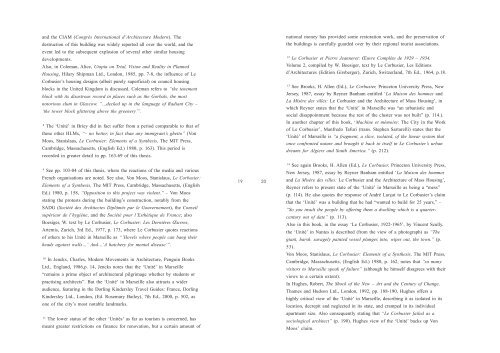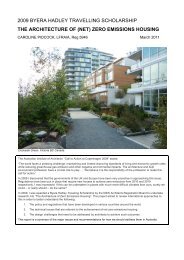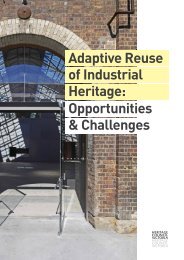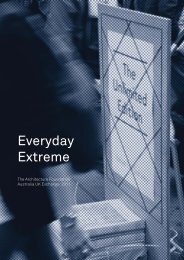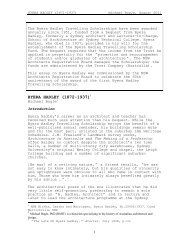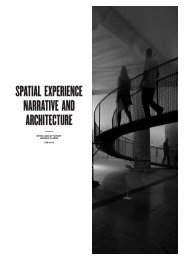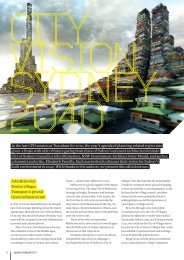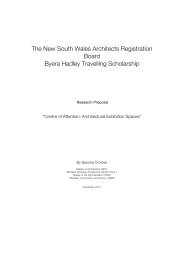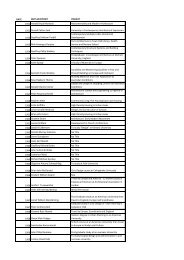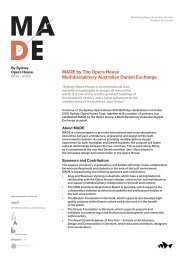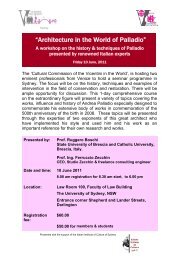4 unités LC - Architecture Insights
4 unités LC - Architecture Insights
4 unités LC - Architecture Insights
Create successful ePaper yourself
Turn your PDF publications into a flip-book with our unique Google optimized e-Paper software.
and the CIAM (Congrès International d’<strong>Architecture</strong> Modern). The<br />
destruction of this building was widely reported all over the world, and the<br />
event led to the subsequent explosion of several other similar housing<br />
developments.<br />
Also, in Coleman, Alice, Utopia on Trial, Vision and Reality in Planned<br />
Housing, Hilary Shipman Ltd., London, 1985, pp. 7-8, the influence of Le<br />
Corbusier’s housing designs (albeit purely superficial) on council housing<br />
blocks in the United Kingdom is discussed. Coleman refers to “the tenement<br />
block with its disastrous record in places such as the Gorbals, the most<br />
notorious slum in Glascow. “…decked up in the language of Radiant City –<br />
‘the tower block glittering above the greenery’”.<br />
8 The ‘Unité’ in Briey did in fact suffer from a period comparable to that of<br />
these other HLMs, “– no better, in fact than any immigrant’s ghetto” (Von<br />
Moos, Stanislaus, Le Corbusier: Elements of a Synthesis, The MIT Press,<br />
Cambridge, Massachusetts, (English Ed.) 1980, p. 163). This period is<br />
recorded in greater detail in pp. 163-69 of this thesis.<br />
9 See pp. 103-04 of this thesis, where the reactions of the media and various<br />
French organisations are noted. See also, Von Moos, Stanislaus, Le Corbusier:<br />
Elements of a Synthesis, The MIT Press, Cambridge, Massachusetts, (English<br />
Ed.) 1980, p. 158, “Opposition to this project was violent.” – Von Moos<br />
stating the protests during the building’s construction, notably from the<br />
SADG (Société des Architectes Diplômés par le Gouvernement), the Conseil<br />
supérieur de l’hygiène, and the Société pour l’Esthétique de France; also<br />
Boesiger, W. text by Le Corbusier, Le Corbusier: Les Dernières Œuvres,<br />
Artemis, Zurich, 3rd Ed., 1977, p. 173, where Le Corbusier quotes reactions<br />
of others to his Unité in Marseille as “’Hovels where people can bang their<br />
heads against walls…’ And…’A hatchery for mental disease’”.<br />
10 In Jencks, Charles, Modern Movements in <strong>Architecture</strong>, Penguin Books<br />
Ltd., England, 1986,p. 14, Jencks notes that the ‘Unité’ in Marseille<br />
“remains a prime object of architectural pilgrimage whether by students or<br />
practising architects”. But the ‘Unité’ in Marseille also attracts a wider<br />
audience, featuring in the Dorling Kindersley Travel Guides: France, Dorling<br />
Kindersley Ltd., London, (Ed. Rosemary Bailey), 7th Ed., 2000, p. 502, as<br />
one of the city’s most notable landmarks.<br />
11 The lower status of the other ‘Unités’ as far as tourism is concerned, has<br />
meant greater restrictions on finance for renovation, but a certain amount of<br />
19 20<br />
national money has provided some restoration work, and the preservation of<br />
the buildings is carefully guarded over by their regional tourist associations.<br />
12 Le Corbusier et Pierre Jeanneret: Œuvre Complète de 1929 – 1934,<br />
Volume 2, compiled by W. Boesiger, text by Le Corbusier, Les Editions<br />
d’<strong>Architecture</strong>s (Edition Girsberger), Zurich, Switzerland, 7th Ed., 1964, p.18.<br />
13 See Brooks, H. Allen (Ed.), Le Corbusier, Princeton University Press, New<br />
Jersey, 1987, essay by Reyner Banham entitled ‘La Maison des hommes and<br />
La Misère des villes: Le Corbusier and the <strong>Architecture</strong> of Mass Housing’, in<br />
which Reyner states that the ‘Unité’ in Marseille was “an urbanistic and<br />
social disappointment because the rest of the cluster was not built” (p. 114.).<br />
In another chapter of this book, ‘Machine et mémoire: The City in the Work<br />
of Le Corbusier’, Manfredo Tafuri (trans. Stephen Sartarelli) states that the<br />
‘Unité’ of Marseille is “a fragment, a slice, isolated, of the linear system that<br />
once confronted nature and brought it back to itself in Le Corbusier’s urban<br />
dreams for Algiers and South America.” (p. 212).<br />
14 See again Brooks, H. Allen (Ed.), Le Corbusier, Princeton University Press,<br />
New Jersey, 1987, essay by Reyner Banham entitled ‘La Maison des hommes<br />
and La Misère des villes: Le Corbusier and the <strong>Architecture</strong> of Mass Housing’,<br />
Reyner refers to present state of the ‘Unité’ in Marseille as being a “mess”<br />
(p. 114). He also quotes the response of André Lurçat to Le Corbusier’s claim<br />
that the ‘Unité’ was a building that he had “wanted to build for 25 years,” –<br />
“So you insult the people by offering them a dwelling which is a quartercentury<br />
out of date” (p. 113).<br />
Also in this book, in the essay ‘Le Corbusier, 1922-1965’, by Vincent Scully,<br />
the ‘Unité’ in Nantes is described (from the view of a photograph) as “The<br />
giant, harsh, savagely painted vessel plunges into, wipes out, the town.” (p.<br />
53).<br />
Von Moos, Stanislaus, Le Corbusier: Elements of a Synthesis, The MIT Press,<br />
Cambridge, Massachusetts, (English Ed.) 1980, p. 162, notes that “so many<br />
visitors to Marseille speak of failure” (although he himself disagrees with their<br />
views to a certain extent).<br />
In Hughes, Robert, The Shock of the New – Art and the Century of Change,<br />
Thames and Hudson Ltd., London, 1992, pp. 188-190, Hughes offers a<br />
highly critical view of the ‘Unité’ in Marseille, describing it as isolated in its<br />
location, decrepit and neglected in its state, and cramped in its individual<br />
apartment size. Also consequently stating that “Le Corbusier failed as a<br />
sociological architect” (p. 190). Hughes view of the ‘Unité’ backs up Von<br />
Moos’ claim.


